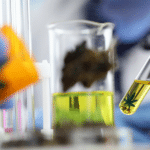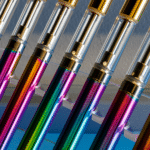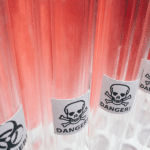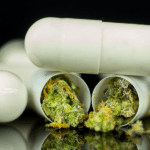“Drug 85 Times as Potent as Marijuana Caused a ‘Zombielike’ state in Brooklyn”
It would be nice to get even a slight journalistic reflection on why people turn to weird black market synthetics to get high in this The New York Times article. Would that really happen if cannabis was legal?
I think not. Prohibition creates the market for completely unheard of drugs that can be talked up as marijuana-like.
While media tends to refer to these drugs merely as “fake pot,” there is some important scientific nuance that gets left out of conversations about cannabinoid synthetics. It’s the brass tacks of what I call the “potency problem.”
Potentcy Versus Efficacy
We all know that weed is “more potent” than ever, right? Because it’s talked about all the time. And occasionally we are reminded of how much more potent the zombifying synthetic “spice” drugs are. The same word—potent—is used to describe what is actually a more complex set of differences between cannabis and its extracts on the one hand, and on the other hand, molecular impersonators of cannabis that are cooked up in clandestine drug labs and spritzed onto dried potpourri.
From a pharmacological perspective, the larger issue is not the greater potency of these compounds, but their greater efficacy. This is pharmacological jargon, but it makes all the difference in the world, and misunderstanding or conflating these concepts contributes to confusion and to guilt by association with respect to cannabis.
Potency refers to the concentration of the drug required to activate a specific receptor. Efficacy refers to the maximal activation of the receptor in response to the drug. Like potency, this is a property of the specific compound and receptor: how much the drug can drive the receptor to engage its cell signaling activities. It isn’t necessarily common sense that these two properties of a drug should be independent of each other, but they are. That’s just the complex cellular biology of drugs and receptors.
To illustrate, say this synthetic drug is 85 times more potent than THC, as The New York Times reported. If you consume 10 mg it would be effectively like consuming 850 mg of THC, if absorption and bioavailability are the same. If potency is the only issue, then a higher dose directly compensates for lower potency.
And this is obviously enough to make a person turn into a doped-out zombie. According to the New England Journal of Medicine, the product was tested at about 16 mg/g. I have seen at least one photo of the source product (“AK-47 24 Karat Gold”) showing that it is sold in a 15 g package of who-knows-what dried plant stuff. At 16 mg/g, this would amount to roughly 240 mg of the synthetic cannabinoid per package, which would crudely convert to something like the raw potency of 20 grams of pure THC. Insane. But even this doesn’t likely explain some of the profoundly disruptive effects of spice-synthetics on users (see reference links below).
The Dangers of Efficacy
What probably makes these synthetic drugs more dangerous than even dabbing cannabis resin all day is their greater efficacy. Pharmacologists also use the term “intrinsic activity” to describe this property of a drug. Based on a drug’s intrinsic activity, it is classified as either “full” or “partial” in its ability to drive the receptor that it targets.
Scientists now realize that receptors are not simple off-on switches. It is much more accurate to say that receptors are like light bulbs on a dimmer switch. A full agonist will crank the receptor to its full level of “brightness” as it communicates to the cell to alter its activity. Partial agonists only go so far (see Figure).
You can dab all the THC you want, even a whopping 850 mg as imagined above, and if the prevailing, mainstream scientific paradigms of pharmacology are true, it won’t make up for the fact that THC is still only a partial agonist (so is anandamide, the brain’s endogenous marijuana-like molecule), whereas the black market synthetics are full agonists. The full agonist drives the receptor to higher levels of intracellular signaling activity than is possible with THC.1 There is evidence that this is causing medical emergencies, including adverse cardiovascular events and stroke (I base this on numerous personal conversations with neurologists in recent years as well as the references below). As new, completely untested synthetic compounds emerge, the risks are unknown and possibly very serious.
Efficacy & Potentcy of THC in Cannabis
To maintain clear thinking on the re-emergence of cannabis-based medicines, we must be vigilant that news reports and political alarm about these ultra-potent, full agonist synthetics are not flippantly applied to cannabis. The media refers to cannabis extracts being more “potent” than cannabis, or simply that weed is more potent than it used to be. Doesn’t that equate to a more potent cannabinoid like those found in the entirely unpredictable Spice products? Makes sense, but that’s flat wrong.
In the context of cannabis itself, a reference to higher potency means simply that you are delivering a higher dose, as a consequence of having higher total THC content in the product. More potent cannabis does not equal a more efficacious drug. It does not turn a partial agonist into a full agonist. The intrinsic activity of THC at human cannabinoid receptors has not changed as cannabis has been bred to increase THC yields, nor does it change as cannabis is extracted and concentrated through modern distillation methods. This is tricky to argue without breaking it down carefully, because it involves molecular pharmacology, and of course, there are always important caveats (see footnotes & postscript).
The Difference Between Cannabis & Synthetic Cannabinoids
But there’s even more reason to say “not so fast” when comparing natural cannabis to the synthetic cannabinoids found on the street. It is quite likely that some of these full agonist synthetics not only drive the classical receptor-activated pathways more strongly than THC or anandamide, but also trigger entirely different cellular signal transduction pathways.
Go back to the dimmer switch analogy, but imagine as you crank up the signaling activity (representing a switch from a partial agonist like THC or anandamide to a full agonist like the synthetics), instead of just making the lights brighter it also starts to change colors, or now it flips on a heating system in the room, too! Recent studies of the CB1 receptor crystal structure are revealing powerful insights by showing how different ligands [receptor activators or blockers] dock to the receptor and influence its shape in distinct ways, which is directly related to how the receptor is functioning when activated by that ligand. (See also: High-resolution crystal structure of the human CB1 cannabinoid receptor)
Importantly, among the dozens of plant cannabinoids in cannabis, none of them evolved to be full agonists of the cannabinoid receptors! THC is clearly the most efficacious phytocannabinoid we know, and it behaves much more like anandamide, meaning it is still a partial agonist, as gentle on our systems as the natural endocannabinoid.2 No matter the concentration/dose, THC will only drive the receptor so much.
The synthetic spice shit is dangerous. I haven’t even mentioned that these compounds may be metabolized into carcinogenic substances. We just don’t know yet, and they are being reinvented all the time, tested not in laboratories but on the streets with no oversight or care about public health impacts. There is very good reason to avoid them altogether. This should underscore that cannabis is much, much less dangerous than synthetic spice products… or better yet, that it’s simply NOT dangerous.
A version of this article was published in South Florida Hospital News and Healthcare Report. Greg Gerdeman, Ph.D. is a neuroscientist and educator. He discloses financial interests as a consultant in the legal medical cannabis and hemp industries. Copyright, Project CBD. May not be reprinted without permission.
Postscript
There are always caveats to discussion of how drugs work and what their long-term consequences may be. I want to acknowledge that, without backing away from expressing my informed opinions on this subject of great importance. Specifically, I don’t want to be cavalier about the long-term safety profile of a high THC dab habit, especially when starting young. There are plenty of unanswered questions about how receptors in the brain change over time, with or without chronic stimulation, and how this might relate to normal aging or the development of psychiatric distress or disease.
Studies that raise real alarm about chronic cannabis use all suggest that starting heavy, daily and young (under 16) with high THC may be a cause for concern. While cannabis itself is a very well known commodity with timeless human use, the ease with which high-THC resins can be so rapidly absorbed using modern dab rigs is not well precedented historically, to my knowledge. Acutely, even THC-tolerant users often tell me that high-THC dabs are too much for them, as a result of rapidly obtaining very powerful THC effects. Such a powerful medicine warrants respect and care.
References
- Jose Orsini, Christa Blaak, Eric Tam, et al., “The Wide and Unpredictable Scope of Synthetic Cannabinoids Toxicity,” Case Reports in Critical Care, vol. 2015, Article ID 542490, 5 pages, 2015. https://doi.org/10.1155/2015/542490.
- Bernson-Leung ME, Leung LY, Kumar S. “Synthetic cannabis and acute ischemic stroke,” J Stroke Cerebrovasc Dis. 2014 May-Jun;23(5):1239-41. doi: 10.1016/j.jstrokecerebrovasdis.2013.07.030. Epub 2013 Oct 8.
- Raheemullah A, Laurence TN. “Repeated Thrombosis After Synthetic Cannabinoid Use.” J Emerg Med. 2016 Nov;51(5):540-543. doi: 10.1016/j.jemermed.2016.06.015. Epub 2016 Aug 29.
Footnotes
- Theoretically, high doses of a partial agonist actually can achieve full efficacy, in the context of what pharmacologists call receptor spareness. Given the extraordinary high density of CB1 receptors in certain brain areas, this phenomenon may prove me wrong, such that for some neurological outcomes, a whopping dose of THC might act in some ways like a full agonist. However, the theory of spare receptors has mostly been demonstrated in cellular expression systems that are manipulated in ways quite unlike brain synapses in their natural context, so its direct relevance is uncertain.
- Or even more so! Some scientific studies have described the endocannabinoid 2-AG to act as a full agonist, but others have not. It likely depends on the specific cell type and lab method utilized.







